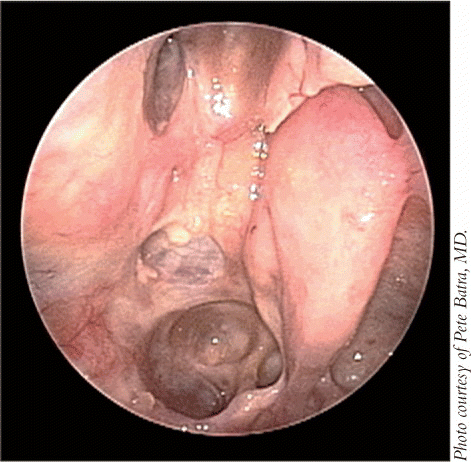The Controversy
Most of the limited experience with endoscopic treatment of malignancies centers on lower-grade lesions, principally esthesioneuroblastomas at the Kadish A/B stage, said Dr. Osguthorpe. Very little information exists, aside from what is technically feasible, on longer-term control of endoscopically resected higher-grade lesions, and as with any topic where there’s inconclusive information yet major interest, it’s controversial, he said.
Explore This Issue
May 2009
During the 1980s, the optimal treatment of esthesioneuroblastoma was a source of debate not among surgeons, but between surgeons and radiation oncologists, because the tumor is relatively sensitive to radiation. Today, most physicians favor surgery for esthesioneuroblastomas, with or without radiation, depending on tumor stage, said Dr. Osguthorpe. If a tumor is early-stage, confined to the nasal cavity, or with modest adjacent sinus involvement, a transnasal endoscopic approach supplemented by external beam radiation to the anterior fossa floor, primarily the olfactory bulb region, may be appropriate, he said (citing Unger et al. Minim Invasive Neurosurg 2001;44: 79-84).
Radiation is expected to control minor disease spread through the cribriform plate, a finding Dr. Osguthorpe encountered in a patient who presented with a 2-cm solely intranasal esthesioneuroblastoma on MRI, yet had microscopic disease in the ipsilateral olfactory bulb.
Alternatively, the surgeon can resect the olfactory region via an endoscopy alone, but challenges associated with defect closure and maintaining the safety of adjacent intracranial structures may arise, said Dr. Osguthorpe, adding that few physicians currently have the expertise to use this approach. For larger tumors with obvious skull base or anterior fossa involvement, a formal craniotomy, endoscopically assisted on the transnasal portion of the procedure, may be prudent, and is usually combined with postoperative irradiation, he said.
Generally, radiation needs to be employed after both endoscopic resection and open craniofacial surgery, said Dr. Kraus. However, the goal of either procedure is to completely resect the entire tumor, he added.
Overall, an endorsement of endoscopic resection of aggressive or advanced malignancies should be withheld until long-term data are available to support its use, said Dr. Osguthorpe, noting that this view was also expressed by Paul Levine, MD, at the Ogura Lecture given at the at the Triological Society 111th Annual Meeting in Orlando, FL, last spring (Laryngoscope 2009;119:3-7; ENT Today 2008(7); 3:8-9).
Moreover, endoscopic treatment of these tumors should occur only in a clinical trial setting with long-term follow-up, so physicians can learn from the experience, added Dr. Osguthorpe.
Leave a Reply